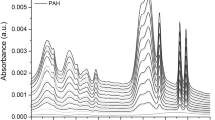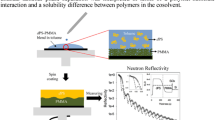Abstract
The thermal expansion of thin deuterated polystyrene (dPS) films supported on energetically repulsive, fluorinated polyimide (PI) substrates (PI/dPS bilayer) was measured via neutron reflectometry as a function of initial dPS film thickness. Film thickness was measured before and after capping with a top layer of the same repulsive, high glass transition polyimide that comprised the substrate layer (PI/dPS/PI trilayer) in an attempt to observe any effects of the dPS free surface in the bilayer geometry. Bulk thermal expansion behavior, characterized by a discontinuous change in coefficient of thermal expansion (CTE) at the glass transition (Tg), is observed in films with thickness > 70 rim. For thicknesses between 70 nm and 40 nm a transition is seen from bulk behavior in bilayer films to glassy thermal behavior in the trilayer films persisting up to 20 °C above the bulk Tg. In films with thickness < 40 nm the bulk glassy CTE persists well above the bulk Tg for both bilayer and trilayer films
Similar content being viewed by others
References
J. Baschnagel and K. Binder, Macromolecules. 28, 6808 (1995).
T. Pakula, J. Chem. Phys. 95, 4658 (1991).
W.E. Wallace, J.H. van Zanten, W.L. Wu, Phys. Rev. E. 52, R3329 (1995).
J.H. van Zanten, W.E. Wallace, W.L.. Wu, Phys. Rev. E. 53, R2053 (1996).
J.L. Keddie, R.A.L. Jones, R.A. Cory, Europhys. Lett. 27, 59 (1994).
J.A. Forrest, K. Dalnoki-Veress, J.R. Dutcher, Phys. Rev. E. 56, 5707 (1997).
T. Kajiyama, K. Tanaka, A. Takahara, Macromolecules. 30, 280 (1997).
O. Prucker, S. Christian, H. Bock, C.W. Frank, W. Knoll, Macromol. Chem. Phys. 199, 1435 (1998).
D.B. Hall, R.D. Miller, J.M. Torkelson, J. P. Sci., B: Phys. 35, 2795. (1997).
S.C.M. Kwan, C. Wu, F. Li, E.P. Savitski, F.W. Harris, S.Z.D. Cheng, Macromol. Chem. Phys. 198, 3605 (1997).
According to ISO 31-8 the term “molecular weight” has been replaced by “relative molecular mass,” symbol Mr Thus, if this nomenclature were to be followed in thispublication, one would write Mr, n instead of the historically conventional M, for the number average molecular weight, with similar changes for Mw, Mz, and My, and it would be called the “number average relative molecular mass.” The conventional notation, rather than the ISO notation, has been employed for this publication.
The data in Figure 1 are presented along with the standard uncertainty (±) involved in the measurement.
The error in the fitted dPS film thickness at different respective temperatures is estimated to be Δthick = 0.1 Å by the fitting procedure which is based on a Marquart-Levenburg fit that minimizes a merit function, χ2, through variation of a group of specified parameters.(14-16) The small magnitude of the uncertainty estimate is a partial consequence of this fitting procedure which minimizes χ2 based on a set of optimized parameters (polyimide films and dPS film thickness, neutron scattering length density, and interfacial roughness between layers) whose individual errors are small but correlated.(16) Although an absolute measure of the individual uncertainty in the dPS film thickness would be beneficial it is not possible to obtain such an estimate for any fitted parameter value resulting from this type of χ2 fitting of the experimental data without imposing an arbitrary criteria of deviation between an optimum fit and a significantly less-than optimum fit. The error estimate provided by the χ2 routine is the least ambiguous estimate for the film thickness measurements in this study.
J.F. Ankner and C.F. Majkrzak, SPIE. 1738, 260 (1992).
W.H. Press et al., Numerical Recipes, 3 rd ed. Cambridge University Press, Cambridge, UK (1992).
A. Asmussen and H. Riegler, J. Chem. Phys. 104, 8159 (1996).
Author information
Authors and Affiliations
Rights and permissions
About this article
Cite this article
Pochan, D.J., Lin, E.K., Satija, S. et al. Thermal Expansion and Glass Transition Behaviour of Thin Polymer Films with and without a Free Surface Via Neutron Reflectometry. MRS Online Proceedings Library 543, 163–168 (1998). https://doi.org/10.1557/PROC-543-163
Published:
Issue Date:
DOI: https://doi.org/10.1557/PROC-543-163




